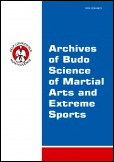2021, Volume 17, Issue 1
The ability to use firearms in stressful conditions as an important criterion for survival
Robert Bąk1
1College of Medical Sciences, Institute of Physical Culture Studies, University of Rzeszow, Rzeszów, Poland
Author for correspondence: Robert Bąk; College of Medical Sciences, Institute of Physical Culture Studies, University of Rzeszow, Rzeszów, Poland; email: rbak@ur.edu.pl
Full text
Abstract
Background & Study Aim: Survival competence is one of the basic areas of utilitarian human skills. Among many, the ability to shoot occupies a special place, especially from the perspective of using weapons in stressful situations (a special case of necessary defence). Factors modifying performance may be age, stress level, emotions, motivation, etc. Of interest is the question of whether the results of so-called static shooting are correlated with the results of simulated shooting situations as a necessity for the use of firearms in necessary defence. The main objective of the research is to know how competent the participants of the shooting instructor course are in the use of firearms in extreme situations (competition based on static shooting standards and dynamic duel "one against one" under safe simulation conditions).
Material & Methods: Twelve participants of a shooting instructor course aged 26-55 years were studied. All subjects were competent in the use of firearms. None of the subjects declared experience in defensive shooting or previous use of weapons with Simunition FX (non-lethal training ammunition). The test subjects first participated in a static shooting competition and then in dynamic duels with another person (simunition weapons and ammunition were used). Stress level was measured by heart rate values (HR Index: difference in heart rate after and before the competition). Motywację do współzawodnictwa mierzono w 10 stopniowej skali (1 motywacja minimalna, 10 maksymalna). Motivation to compete was measured on a 10-degree scale (1 minimum motivation, 10 maximum). The use of special ammunition provided simulated conditions of imminent threat to health or life during real-life defensive combat with firearms. This methodological procedure allowed not only the competence of the test subjects in the use of firearms under stressful conditions to be assessed, but also the ability to act with precision during the effort. The opponent during the duel was an independent shooter (the same for all participants). The test ("shooting duel") took place over a distance of 10 m at the signal of the judge. During the duel, competitors were allowed to take any shooting stance they wished, without reducing the distance to the opponent. Each shooter had 10 rounds of ammunition (5 rounds in each of two magazines).
Results: A high level of shooting skills was found in the static subjects: mean score of 39.9 (out of a possible 50) with a mean motivation of 9.1. The age of the subjects was not significantly related to performance, nor was stress level. In the static competition, the mean HR before the competition was 86.3 BPM just after the competition 87.4 BPM. The mean HR Index was 1.1 BPM (in some cases it had negative values). There was a highly significant correlation (r = 0.715) of motivation with competition performance. In contrast, duel results showed no statistically significant correlation with shooting performance under static conditions. The stressful situation manifested itself in an apparent increase in the participants' heart rate: the average HR before the duel was 92.4 BPM, just after the competition 111.3 BPM; the average HR Index was 18.9 BPM. There was no significant correlation (r = 0.261) between duel motivation (mean 9.5) and shooting performance (mean 1.8 hits).
Conclusions: The shooting instructor candidates surveyed demonstrated high competence in the use of firearms under static conditions, while this was not confirmed by the results of shooting under simulated conditions of necessary defence. Thus, the ability to use firearms in self-defence, as an important element of survival competence, requires specialised training under conditions that are close to a real threat. The results of this research extend the empirical evidence of the need to introduce simulated direct threat situations into the training of defensive shooting educators. Such innovations will meet the methodological criteria of training precision action during exertion and stress as core survival competencies.
Key words: education for safety, shooting simulation, survival awareness





